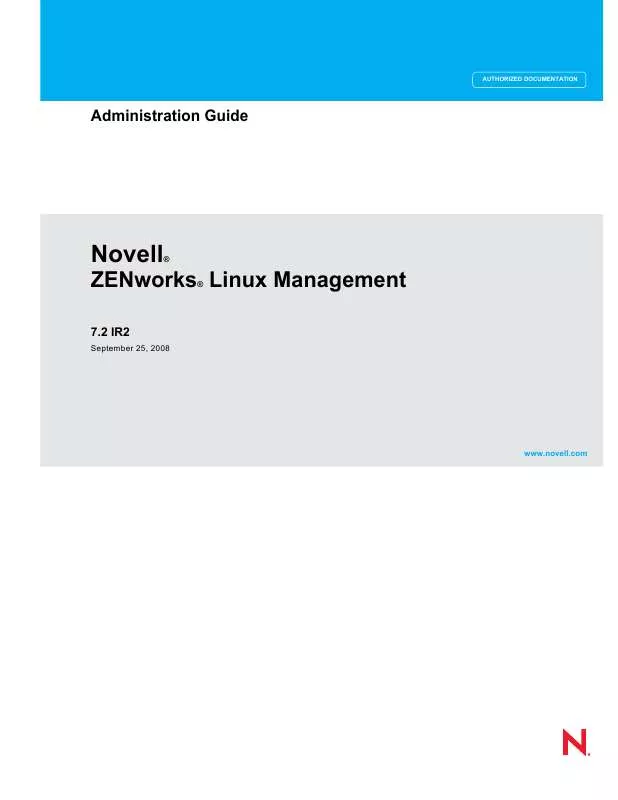Detailed instructions for use are in the User's Guide.
[. . . ] novdocx (en) 11 July 2008
AUTHORIZED DOCUMENTATION
Administration Guide
Novell®
7. 2 IR2
ZENworks® Linux Management
September 25, 2008
www. novell. com
Novell ZENworks 7. 2 Linux Management Administration Guide
novdocx (en) 11 July 2008
Legal Notices
Novell, Inc. makes no representations or warranties with respect to the contents or use of this documentation, and specifically disclaims any express or implied warranties of merchantability or fitness for any particular purpose. reserves the right to revise this publication and to make changes to its content, at any time, without obligation to notify any person or entity of such revisions or changes. makes no representations or warranties with respect to any software, and specifically disclaims any express or implied warranties of merchantability or fitness for any particular purpose. [. . . ] Physically connect the device to the lab network. If you are using Preboot Services, boot the device from the Preboot Services imaging server.
Understanding Preboot Services in ZENworks Linux Management 339
novdocx (en) 11 July 2008
or If you are not using Preboot Services, boot the device with the imaging boot CD or DVD and install the ZENworks partition. For more information, see Step 3 on page 355 of Section 29. 7. 2, "Enabling a Device for Imaging Operations, " on page 394. After you have installed the partition, reboot the device from the ZENworks partition. At the end of each lab session, assign the Preboot bundle to the lab devices. Reboot each device and let it be auto-imaged by its assignment to a ZENworks Preboot bundle.
28. 5. 5 Setting Up Devices for Future Reimaging
With minimal disruption to users, you can enable existing devices for possible future reimaging. This process might need to be phased in by local administrators. Each administrator can do the following: 1. Install the Novell ZENworks Linux Management Imaging Agent (novell-zislnx) on each device. If the devices are PXE capable, make sure PXE is enabled (see Section 29. 6, "Enabling PXE on Devices, " on page 392) and make sure that ZENworks Linux Management is installed on your imaging server (see Section 29. 1, "Preparing a Preboot Services Server, " on page 345). or Prepare a few sets of imaging CDs or DVDs that users can use when they run into trouble (see Section 29. 2, "Setting Up the Preboot Services Methods, " on page 346). These devices should point to an imaging server that contains the same clean images used for new devices. If a user runs into trouble, use the strategy for reimaging corrupted devices. For more information, see Section 28. 5. 3, "Reimaging Corrupted Devices, " on page 339.
28. 5. 6 Multicasting Device Images
The following sections explain the multicasting images feature: "Understanding Multicasting" on page 340 "Practical Uses For Multicasting" on page 341 "Automatic Multicasting Example" on page 342 For instructions on using multicasting, see Section 30. 2, "Multicasting Images, " on page 419. Understanding Multicasting Multicasting is a way to send the same image to multiple devices without sending that image multiple times across the network. It is done by inviting participants to join a multicast session. Multicasting is similar to broadcasting on the network, because you send the image once to the network and only those devices belonging to the multicast session can see and receive it. For example, if you have 10 devices in the multicast session and the image is 3 GB in size, your network experiences only 3 GB of network traffic to image all 10 devices. Without multicasting, the network experiences 30 GB of network traffic to image all 10 devices individually.
340 Novell ZENworks 7. 2 Linux Management Administration Guide
novdocx (en) 11 July 2008
The devices to be imaged must be physically connected to the network. They can be devices with existing operating systems of any kind, or they can be new devices with no operating system installed. IMPORTANT: For multicasting to work properly, all routers and switches on the network must have their multicast features configured. Otherwise, multicast packets might not be routed properly. [. . . ] The changes are explained below.
L. 3. 1 Appendix
The following changes were made in this section:
Location Change
zlmmirror (1) (page 540)
Updated this section.
L. 4 May 19, 2008 (Interim Release 2)
Updates were made to the following sections. Section L. 4. 1, "ZENworks System Management, " on page 667 Section L. 4. 2, "Package and Content Management, " on page 667 Section L. 4. 3, "Preboot Services, " on page 667
666 Novell ZENworks 7. 2 Linux Management Administration Guide
novdocx (en) 11 July 2008
Section L. 4. 4, "Event Monitoring, " on page 668 Section L. 4. 5, "Appendix, " on page 668
L. 4. 1 ZENworks System Management
The following changes were made in this section:
Location Change
Section 7. 12, "Configuring the ZENworks Server Preferences, " on page 76 Section 7. 13, "Understanding the StoreFileDeps Preference, " on page 77
Added this section.
Added this section.
Section 9. 1. 3, "Deleting the Added this section. Dangling Objects from ZENworks Object Store, " on page 84 Section 9. 5, "Cleaning Up the ZENworks Database, " on page 94 Added this section.
L. 4. 2 Package and Content Management
The following changes were made in this section:
Location Change
Chapter 19, "Understanding Added this chapter. RPM Packages, " on page 207 Section 25. 3. 3, "Mirroring Added this section. [. . . ]


 NOVELL ZENWORKS LINUX MANAGEMENT 7.2 IR2 INSTALLATION GUIDE 07-20-2009 (1473 ko)
NOVELL ZENWORKS LINUX MANAGEMENT 7.2 IR2 INSTALLATION GUIDE 07-20-2009 (1473 ko)
 NOVELL ZENWORKS LINUX MANAGEMENT 7.2 IR2 TROUBLESHOOTING GUIDE 08-22-2008 (745 ko)
NOVELL ZENWORKS LINUX MANAGEMENT 7.2 IR2 TROUBLESHOOTING GUIDE 08-22-2008 (745 ko)
